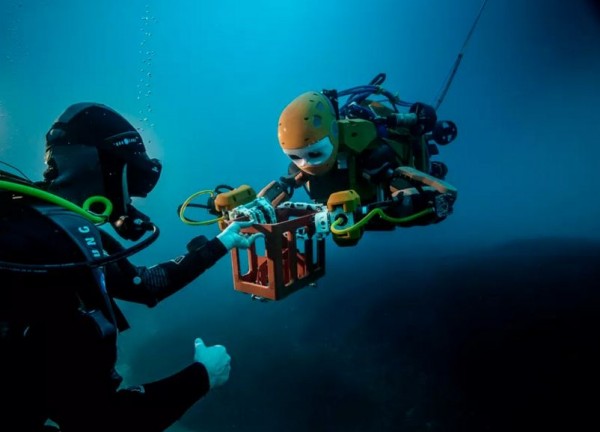Fall in love with OceanOne, the world’s first robo-mermaid
| Arthur Dominic Villasanta | | Apr 28, 2016 09:12 PM EDT |
(Photo : Frederic Osada and Teddy Seguin/DRASSM) OceanOne robo mermaid
"It" looks like a "she" from a distance underwater. And this swimming "robo-mermaid" named "OceanOne" is the first of its kind in the world.
OceanOne is a humanoid robot designed to accomplish delicate tasks underwater. It recently took its first operational test dive in the Mediterranean Sea and recovered a 17th century vase from the sunken wreck of a French man-of-war La Lune from the time of Louis XIV.
Like Us on Facebook
Designed by Stanford University, OceanOne relies on artificial intelligence (AI) to accomplish its missions. It also possesses haptic feedback systems that give its human controller the unparalleled ability to feel what the robot's hands feel. Its controller uses joysticks to maneuver the humanoid from a boat.
The female looking OceanOne stands some 1.5 meters tall. It has stereoscopic vision for better vision and a pair of fully articulated arms. It's steered by eight multi-directional thrusters and can operate at depths in excess of 100 meters.
It took the Stanford team led by Oussama Khatib four years to design and build OceanOne. Khatid said the aim of the team was to build a robot that can be the physical representation of a human. In other words, the orange colored OceanOne is an avatar that allows its human controller to be present virtually.
He said the most amazing thing about the robot is that the human controller can feel what the robot's hands feel through haptic feedback, a technology popularized by mobile phones.
"It's almost like you are there," said Khatid. "With the sense of touch you create a new dimension of perception."
OceanOne finds its way underwater by using its cameras and sensors to detect the environment. Its AI allows it to avoid colliding with underwater objects. But in case it senses it can't avoid a collision, the humanoid will extend its arms to soften the impact, a very human response.
Stanford researchers intend to have OceanOne explore coral reefs and underwater disaster zones, including radioactive ones, among many other sites.
Their main goal is to build a robot that can tackle tasks that are too dangerous or physically impossible for humans to safely accomplish. They intend to build fleets of these robots to allow humans ot explore more of the ocean depths.
©2015 Chinatopix All rights reserved. Do not reproduce without permission
EDITOR'S PICKS
-

Did the Trump administration just announce plans for a trade war with ‘hostile’ China and Russia?
-

US Senate passes Taiwan travel bill slammed by China
-

As Yan Sihong’s family grieves, here are other Chinese students who went missing abroad. Some have never been found
-

Beijing blasts Western critics who ‘smear China’ with the term sharp power
-

China Envoy Seeks to Defuse Tensions With U.S. as a Trade War Brews
-

Singapore's Deputy PM Provides Bitcoin Vote of Confidence Amid China's Blanket Bans
-

China warns investors over risks in overseas virtual currency trading
-

Chinese government most trustworthy: survey
-

Kashima Antlers On Course For Back-To-Back Titles
MOST POPULAR
LATEST NEWS
Zhou Yongkang: China's Former Security Chief Sentenced to Life in Prison

China's former Chief of the Ministry of Public Security, Zhou Yongkang, has been given a life sentence after he was found guilty of abusing his office, bribery and deliberately ... Full Article
TRENDING STORY

China Pork Prices Expected to Stabilize As The Supplies Recover

Elephone P9000 Smartphone is now on Sale on Amazon India

There's a Big Chance Cliffhangers Won't Still Be Resolved When Grey's Anatomy Season 13 Returns

Supreme Court Ruled on Samsung vs Apple Dispute for Patent Infringement

Microsoft Surface Pro 5 Rumors and Release Date: What is the Latest?











